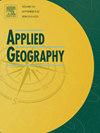On framing flood risk communications through maps: Effects on the real estate market
IF 4
2区 地球科学
Q1 GEOGRAPHY
引用次数: 0
Abstract
Flood maps are commonly used for flood risk communication. Misinterpretation of these maps can lead to over-heightened flood risk perception, with adverse risks for real estate markets. We, therefore, aim to identify an appropriate approach for framing these maps to mitigate such risks. To do this, we carry out five randomised control trials (RCT) in the UK and Pakistan, with each RCT asking a different group of 40 residents in each country to specify their willingness-to-pay (WTP) for coastal residential properties. In the first RCT, we provide no flood risk map. In each subsequent RCT, we provide a flood risk map framed differently. Our flood risk map frames include those with technical language, colour variations, and more accessible risk information. Our findings indicate that real estate demand uncertainty increases in response to flood risk maps, regardless of the framing approach used. We find that there is less WTP for properties in any zones with flood risk information, regardless of whether the risk is very low. This finding indicates that risk aversion takes precedence in real estate decisions under flood risk maps, leading to property devaluation in all flood risk zone categories. We discuss the wider implications of these findings.
通过地图构建洪水风险沟通:对房地产市场的影响
洪水地图通常用于洪水风险通报。对这些地图的误解可能导致对洪水风险的过高认识,给房地产市场带来不利风险。因此,我们的目标是确定一种适当的方法来构建这些地图,以减轻此类风险。为了做到这一点,我们在英国和巴基斯坦进行了五项随机对照试验(RCT),每个RCT要求每个国家的40名不同的居民指定他们对沿海住宅物业的支付意愿(WTP)。在第一个RCT中,我们没有提供洪水风险图。在随后的每个随机对照试验中,我们提供了一个框架不同的洪水风险图。我们的洪水风险地图框架包括那些带有技术语言、颜色变化和更容易获取的风险信息的地图框架。我们的研究结果表明,无论采用何种框架方法,房地产需求的不确定性都会随着洪水风险图的变化而增加。我们发现,在任何有洪水风险信息的区域,无论风险是否非常低,物业的WTP都较少。这一发现表明,在洪水风险地图下,风险规避优先于房地产决策,导致所有洪水风险区域类别的房地产贬值。我们讨论了这些发现的更广泛的含义。
本文章由计算机程序翻译,如有差异,请以英文原文为准。
求助全文
约1分钟内获得全文
求助全文
来源期刊

Applied Geography
GEOGRAPHY-
CiteScore
8.00
自引率
2.00%
发文量
134
期刊介绍:
Applied Geography is a journal devoted to the publication of research which utilizes geographic approaches (human, physical, nature-society and GIScience) to resolve human problems that have a spatial dimension. These problems may be related to the assessment, management and allocation of the world physical and/or human resources. The underlying rationale of the journal is that only through a clear understanding of the relevant societal, physical, and coupled natural-humans systems can we resolve such problems. Papers are invited on any theme involving the application of geographical theory and methodology in the resolution of human problems.
 求助内容:
求助内容: 应助结果提醒方式:
应助结果提醒方式:


